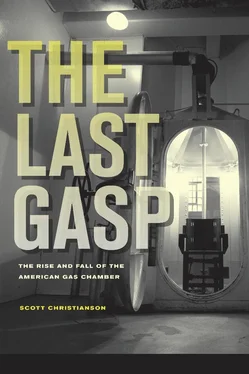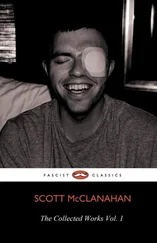In 1884 Sir Benjamin Ward Richardson, a British pioneer in anesthesiology, delivered a lecture to London’s Society of Arts entitled “On the Painless Extinction of Life in the Lower Animals,” in which he traced the history of gases and vapors that could be used to carry out the humane slaughter of dogs and cats. Richardson designed a wood-and-glass container, large enough to hold a Saint Bernard or several smaller animals, which was connected to a slender tank full of carbonic acid gas and a heating apparatus. At the time, unwanted horses, dogs, and other animals were a pressing social problem, seen as contributing to disease and other maladies, and animal euthanasia seemed to offer many benefits. Gases were already on everyone’s mind, particularly in London, the world’s largest city at the time and known for its filthy fog and foul vapors that belched forth from hundreds of thousands of coal-burning chimneys and steam engines. In one four-month stretch alone, the winter of 1879 to 1880, an estimated three thousand people perished from aggravated lung conditions, as the daytime air became so dark that pedestrians stumbled to their death in the Thames. 4Residents coughed and choked in a sulfurous haze. It was precisely then and there, amid such foul pollution, that notions of a lethal gas chamber assumed greater currency, and “humane societies” throughout Europe adopted Richardson’s lethal chamber to remove unwanted animals. 5Scientists tested carbon dioxide as a possible cure to the animal overpopulation problem, oblivious to the fact that its use would only make the air worse for everyone.
At first such use was reserved for small animals, who were “put to sleep” behind closed doors, away from inquiring eyes, but soon many prominent eugenicists openly remarked about what others had only privately imagined: why not try it out on humans? 6Writing at the dawn of the twentieth century, H. G. Wells often mentioned “lethal chambers for the insane” and mused that the “swarms of black, brown, and dirtywhite, and yellow people… have to go.” 7Another British eugenicist of that time, Robert Rentoul, called for “degenerates” convicted of murder to be executed in a “lethal chamber.” 8The novelist D. H. Lawrence gave “three cheers for the inventors of poison gas,” saying, “If I had my way, I would build a lethal chamber as big as the Crystal Palace, with a military band playing softly, and a Cinematograph working brightly, and then I’d go out in back streets and main streets and bring them all in, all the sick… the maimed; I would lead them gently, and they would smile me a weary thanks.” 9The dramatist George Bernard Shaw also favored mass use of the lethal chamber. 10Such talk became so prevalent that some commentators even began using the noun as a verb, saying so-and-so ought to be “lethal chambered.”
Yet although eugenics (“good birth”) and euthanasia (“good death”) were closely interrelated in language and thought, not all eugenics advocates supported euthanasia. Debates about the morality of eliminating mental defectives and other types of the “unfit” widened some major schisms within the eugenics movement. In the meantime, however, notions of using a lethal chamber for large-scale euthanasia nevertheless had become part of the public discourse. 11
Another significant development in the discussion that would turn into the eugenics movement was set in motion in July 1874, when a frail and chronically ill gentleman from New York City, Richard Louis Dugdale, visited a dingy local jail in New York’s Hudson Valley as a volunteer inspector for the New York Prison Association. Dugdale was shocked to learn that six persons under four family names, all of them blood relatives to some degree, were incarcerated in the same Ulster County institution, and that of twenty-nine males who were their “immediate blood relations,” seventeen had been arrested and fifteen were convicted of various crimes. He decided to examine the family in order to determine how they had come to be so criminal. The sheriff directed Dugdale to two longtime residents of the area, one of them an eighty-four-year-old former town physician who obligingly provided detailed personal information about the prisoners’ kin, most of whom were his former patients. The researcher also culled data from local poorhouse records, court and prison files, and interviews with local residents, which he wrote up in the Boston Medical and Surgical Journal and in a little book on the subject, The Jukes: A Study in Crime, Pauperism, Disease, and Heredity , which was published by G. P. Putnam’s Sons in 1877.
In his book he claimed that the six prisoners “belonged to a long lineage, reaching back to the early colonists, and had intermarried so slightly with the emigrant population of the old world that they may be called a strictly American family. They had lived in the same locality for generations, and were so despised by the reputable community that their family name had come to be used generically as a term of reproach .” Dugdale said he had traced the family’s Hudson Valley roots back seven generations to a colonial frontiersman named Max, a descendant of the early Dutch settlers who lived in the backwoods as a “hunter and fisher, a hard drinker, jolly and companionable, averse to steady toil.” His genealogical research indicated that different branches of the family had experienced characteristic types of failure. One branch that appeared to have produced an inordinate number of criminals was traced back to a woman “founder,” Margaret, whom Dugdale called the “Mother of Criminals,” who had married one of Max’s sons. Presenting large genealogical charts and descriptions of each family member, each listed only by first name or code, Dugdale concluded that of 709 Jukes or persons married to Jukes, more than 200 had been on relief and 64 ended up in the poorhouse, indicating a tendency that was several times greater than that of other New Yorkers. Eighteen had kept brothels, 128 had been prostitutes, and more than 76 were convicted criminals. The author estimated their social problems had cost the public, through relief, medical care, police arrests, and imprisonment, a total of $1,308,000 (about $20.9 million in today’s dollars)—a figure that astounded and appalled many taxpayers.
Dugdale’s strange study was hailed as a landmark work in social science, in part because he had conducted extensive field research to attempt to address the question of whether hereditary or environmental factors were more responsible for pauperism, crime, and other social maladies. Although the author did not definitively ascribe the Jukes’ social pathology solely to heredity, and had left open the possibility that what they had actually inherited was a common environment, subsequent writers used Dugdale’s book to buttress their claims about biological or innate inferiority. The study made the Jukes the most notorious and despised clan in the world, but few persons outside Ulster County knew their true identity because Dugdale had used a pseudonymous surname. Although he had explained the name that he had chosen—it was derived from the slang “to juke,” which referred to the erratic nesting behavior of chickens, which deposited their eggs wherever it was convenient—some readers may have also thought the name sounded like “Jews.”
Forty years after Dugdale’s study first appeared, a field worker employed by the Eugenics Record Office in Cold Spring Harbor, New York, Arthur H. Estabrook, conducted a follow-up study using Dugdale’s original records and code sheet. In it, Estabrook claimed to have traced 1,402 additional members of the Jukes clan and found that they were as “unredeemed” and as plagued by “feeblemindedness, indolence, licentiousness, and dishonesty” as their predecessors. Dugdale’s report, the Estabrook update, and other related works all helped to build an empirical foundation for views about “degenerate” classes and what needed to be done about them. It would not be for many more decades that people would begin to expose the studies’ methodological flaws. 12
Читать дальше












